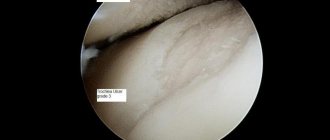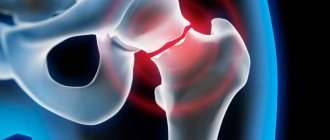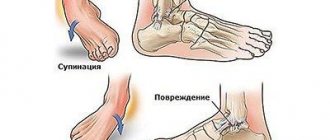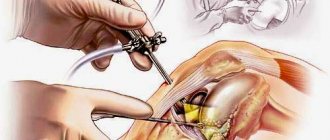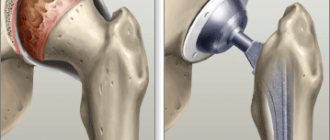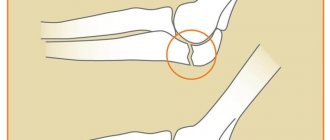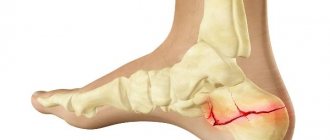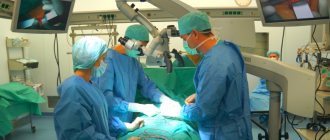Knee joint replacement (KJR) is a method of surgical treatment of the consequences of degenerative pathogenesis of the knee. The purpose of the operation is to completely restore the functions of the problematic part of the limb by replacing the irreversibly damaged joint with an endoprosthesis. Gonarthrosis of the 3rd degree (in 85% of cases) is the most common cause.
Osteoarthritis of the knee joint on x-ray.
This is what the affected joint looks like through an arthroscope. Note the area of missing cartilage surface.
In approximately 98% of cases, surgery predicts a favorable outcome. Upon completion of high-quality rehabilitation, motor and support functions are completely restored, painful symptoms disappear, and the person returns to a normal healthy life. The effect of successful treatment lasts for more than 15 years.
Indications for replacement
Look at the x-ray, you can see the extent to which, with advanced gonarthrosis, the hyaline cartilage, which ensures smooth gliding of the articular surfaces, is worn out. The end sections of the bones are grossly deformed, disrupting the functions of flexion and extension of the limb, causing intense pain.
Comparison of a healthy and affected joint.
When surgery is inevitable
Main indications
- gonarthrosis, accompanied by pronounced functional disorders, persistent painful symptoms, valgus or varus deformity of the legs;
- aseptic necrosis of the femoral condyles;
- autoimmune diseases that result in degeneration of joint tissues - ankylosing spondylitis, systemic lupus erythematosus, gout, rheumatoid arthritis;
- an incorrectly healed fracture that cannot be corrected by other methods;
- congenital abnormalities of the joint structure;
- local neoplasms in the osteochondral structures of the knee, which require mandatory resection.
Surgical technique
According to the diagnosis, age and weight criteria, physical characteristics and concomitant diseases, the specialist chooses the most effective implantation tactics:
- partial replacement (unicondylar) - only one of the semicircular eminences of the femur with the underlying proximal fragment of the tibia is subject to prosthetics (used in elderly patients and people with low physical activity);
- total surgery (complete) – the entire knee joint is changed, it is completely removed, and an endoprosthesis is implanted in its place;
Incomplete implants installed during partial replacement have a short lifespan. Such models are produced 2 times faster than total structures, while their strength potential is not designed for high levels of physical stress. The advantages of partial prosthetics are that only a certain part of the joint is replaced with an implant, the rest of the area remains untouched. Thus, gentle intervention allows you to shorten the rehabilitation period and endure the recovery period relatively easily.
Two surgical techniques in one patient.
Differences from total arthroplasty
For a long time, TKA (total knee replacement) was recognized as the leading method in the treatment of osteoarthritis. What are the advantages of unicondylar endoprosthetics:
- Much less surgical intervention;
- Fast recovery period (within a few months the patient can return to his daily physical activities);
- Pain syndrome is less pronounced (both at rest and during intense physical activity);
- After partial endoprosthetics, people are half as likely to complain about difficulties when using a car than after total;
- There are half as many cases of limited knee flexion and contractures;
- Much more often, people with a partial endoprosthesis have access to a squatting position, getting in and out of vehicles, bending over and lifting objects from the floor, and running.
A number of undeniable and important advantages of unipolar prosthetics. Most foreign colleagues emphasize the similarity of the results presented.
Comparison of two types of operations.
What types of endoprostheses are there?
Prosthetic systems come with a movable or fixed platform, and also provide for the preservation or removal of the posterior cruciate ligament. They differ in the type of fixation; it can be cemented, cementless or combined.
- Movable and fixed platforms .
Most patients receive an implant with a shock-absorbing liner that is tightly connected to the tibial element, that is, products with a fixed platform. The presence of a mobile insert inside the metal tibial component requires good condition of the muscular system and capsular-ligamentous apparatus, otherwise displacement of the prosthesis may occur. The implant allows movement in two planes. - Related and Unrelated Designs. Unconnected models are implanted more often in young people, physically strong, with satisfactory condition of the knee ligaments. Bound, if the ligaments of the knee are seriously damaged.
Implant diagram.
- Fixation methods . It is always made using bone cement.
- Friction unit materials. Combinations of friction pairs, such as metal-polyethylene, or black ceramics-polyethylene. Metal parts are usually titanium-based alloys, cobalt-chrome alloys or steel alloys. Ceramic prostheses in combination with high molecular weight polyethylene have better wear resistance and durability, but they will be more expensive than systems from the metal-polyethylene classification. Typically, ceramic-polyethylene is placed on patients leading an active lifestyle.
Increasingly, a ceramic femoral component is being used instead of a metal one. The image shows the degree of surface wear. The ceramics are not damaged at all.
Attention! The implant can last from 15 to 30 years, but subject to high-quality knee replacement and rehabilitation.
Disadvantages of partial replacement
Be that as it may, partial endoprosthetics has two significant disadvantages: the fragility of the prosthesis and the need for normal functioning of the ligamentous apparatus. In people with a sedentary lifestyle, the joint will last a maximum of 7-10 years, after which secondary surgical intervention is required.
People who adhere to the right lifestyle can count on 15 or even 20 years of carefree life. Zimmer dentures are stable for 10 years in 98% of cases, 15 years in 80%, and 20 years in 70% of cases.
Biomet can surprise with the survival rate of its prostheses in 98% of cases and guarantee an implant lifespan of up to 20 years.
How to get a quote for a knee replacement?
The 2021 quota applies to officially recognized disabled people due to gonarthrosis. Within the framework of the VMP program, people who need revision (repeated) intervention can count on receiving a quota if the primary procedure was performed incorrectly, which resulted in complications.
To undergo free surgery, you will need to get on the waiting list to replace the problematic knee joint with an endoprosthesis. What is needed for this?
- First, you undergo all the necessary examinations at your clinic, where you are registered.
- Next, a complete package of medical documentation, including all diagnostic results, an extract from the medical history, a written statement from the patient, photocopies of the passport, health insurance certificate and the Compulsory Health Insurance policy, is certified by the head physician.
- Then the certified documentation is sent for review to the quota department of the local health authority. There they study it and give consent, about which you will be informed, the documents are sent to a clinic that specializes in installing knee implants.
- The clinic notifies the local health center about the date of the surgical session. The city health authority will contact you and you will need to come and pick up a referral for surgery. The referral will indicate exactly the date of the planned intervention and the clinic where you will receive VMP.
After approval by the local health authority, you will still need to wait from 3 months to 1.5 years to be invited to a particular hospital for treatment.
Knee replacement in the Czech Republic: guarantees, prices, rehabilitation, reviews and statistics.
Find out more
How can a foreign patient make an appointment and the operation itself?
In order to assess the condition of the knee joint, it is necessary to provide the results of MRI diagnostics, as well as x-rays. After viewing the sent images, within 1-2 business days you will receive all the necessary information, a treatment proposal, as well as an estimate of the costs of surgical treatment.
Foreign patients can make an appointment with a Gelenk Clinic specialist in a short time frame that suits their plans. If you need to postpone your trip, we will refund your advance payment in full.
For foreign patients, we try to reduce the time between preliminary examination and surgical intervention to a minimum. This way you will not need to come to the clinic several times. During your outpatient and inpatient stay at the Gelenk Clinic in Freiburg, our multilingual patient management staff (English, Russian, Spanish, Portuguese) will answer all your questions. In addition, we provide a translator (for example, into Arabic), which is paid for by the patient himself. Also, we will be happy to help you organize a transfer, find a hotel and tell you how to spend your free time in Germany for you and your relatives.
Send request
Preparing for surgery
We will talk about how to prepare so that after undergoing endoprosthetics you can easily recover.
- Firstly, start studying physical therapy, at least 2-3 months before the scheduled procedure. It is better if you attend classes under the supervision of a physical therapy instructor. Swimming in the pool and aqua gymnastics are excellent for increasing muscle endurance, so be sure to take note of this.
Make at least minimal movements.
- Secondly, lose weight, if your weight parameters do not correspond to normal values. Even by losing a few kilograms, you will significantly ensure a more harmonious rehabilitation period, which will not be complicated by extra loads aggravating the operated area. Losing weight will extremely reduce the risk of developing unpleasant consequences in the form of premature failure of the prosthesis.
With excess weight: the suture heals worse, anesthesia is more difficult, rehabilitation is more difficult and longer, and the endoprosthesis wears out faster.
Fight bad habits. Quit smoking within 3 months, eliminate alcoholic beverages, and never return to them again. Both the first and second are evil enemies, inhibiting the body’s natural abilities to regenerate tissues injured during surgery, including resisting all possible intra- and post-operative negative phenomena.
Smoking slows down regeneration processes, stop smoking.
Prepare your home:
- The first thing you need to do is securely attach grab bars in the toilet and bathroom , which will serve as safety elements until your recovery.
- in your house or apartment should interfere with movement and should not be a potential cause of injury. Therefore, remove rugs, telephone and electrical cables from the floors, and pieces of furniture standing in the middle of the rooms.
- To take the correct posture when sitting on a chair or taking a lying position, without bending the limb more than 90 degrees, you need to elevate all surfaces for lying and sitting.
- All essential items and things should be at an accessible level so that it does not occur to you to suddenly reach for them, bend over, squat and, God forbid, stand on stools and other supporting elements.
A very useful thing in everyday life.
How to prepare properly?
Before installing a knee endoprosthesis, it is necessary to undergo a comprehensive examination of bone and cartilage tissue, as well as the body as a whole. Methods for assessing the condition of the skeleton include the following examinations:
- densitometry – allows you to measure bone mineral density and determine the severity of osteopenia and the degree of osteoporosis;
- blood test for ionized calcium;
- determination of the level of osteoresorption marker b-Cross Laps (i-ctx) in serum.
If excessively reduced bone density is detected during preoperative preparation, additional therapeutic measures are necessary. The patient is prescribed medications that regulate phosphorus-calcium metabolism, vitamin D and calcium preparations. If significant risk factors are present, preventive therapy may be recommended. This significantly reduces the risk of developing early joint instability.[iii]
To assess the condition of the area of proposed intervention, several instrumental studies are carried out:
- X-ray of both knee joints in 2 projections;
- Ultrasound;
- magnetic resonance imaging;
- arthroscopy (if indicated).
A series of laboratory tests are prescribed to assess the general condition of the patient, the health of his internal organs and the hemostatic system. Other additional laboratory tests may be performed on an individual basis. For example, patients with a history of frequent allergic reactions are prescribed skin patch tests.
The patient has the opportunity to independently improve the prognosis after surgery: strengthening the immune system with proper nutrition, proper hardening, weight loss - all this objectively helps the body successfully undergo the operation and quickly adapt to new conditions.
Before knee replacement, it is advisable for a patient to master a set of exercises to strengthen muscles and train joints, which will be used during rehabilitation after surgery. This will speed up recovery after knee replacement; for the same purpose, the patient is trained in the correct handling of auxiliary devices: crutches, a cane, a stick.
Surgical process
Knee replacement is performed under epidural anesthesia. An anesthetic drug is injected into the epidural space of the spine, which causes complete blocking of pain sensitivity in the lower extremities, while the patient remains conscious.
How the surgeon sees the joint during surgery.
Stages of the classic operation:
- First, a broad antiseptic treatment of the skin of the problematic leg is performed, after which the limb is covered with a film.
- Next, the surgeon makes an incision into the soft tissue on the front side of the knee, carefully exposing the affected joint.
- After opening the joint, pathological growths and free osteochondral fragments are removed.
- The bone units are aligned along the axis, the surface layers are removed from the femur and tibia, then the sawn-off components are polished.
- A small channel is created in the tibia, into which the posterior sleeve of the prosthesis is immersed. This flat metal or ceramic plate follows the geometry of the marginal bone area, with an elastic polymer insert.
- A part of the endoprosthesis is fixed onto the treated femur, which in shape imitates the natural roundness of the lower part of the femur bone.
- At the end of the procedure, the wound is washed generously, hemostasis is performed, a drainage system is installed, and the incision is sutured in layers using the interrupted suture technique. The surgical process is completed by applying a tight sterile bandage to the limb.
The surgical process lasts on average 2 hours. When the knee replacement surgery is completed, the patient is transferred to the intensive care unit for several hours. In the intensive care unit, medical staff closely monitor all life cycles of the body. Then the operated person is transferred to a regular ward, where they begin to implement a comprehensive rehabilitation program specially designed for a particular patient.
Consultation
During the consultation, the doctor will determine the indications and contraindications for joint replacement, conduct the necessary studies and select the appropriate prosthesis. An X-ray examination will allow you to determine the degree of wear of the joint and make the necessary measurements. You will be warned about possible risks and complications of the operation. Complications of the operation include the following:
- infection at the surgical site
- blood loss during or after surgery
- thromboembolism (blockage of a vessel with a blood clot)
Recovery time
2.5-3 months is the time needed for the artificial structure to finally take root and develop, and for the patient to fully adapt to life with a new joint.
A well-healing suture approximately 10 days after surgery.
The entire recovery period can last 2.5-3 months, and sometimes up to six months. Without rehabilitation, there is no point in undergoing a knee replacement. That's why:
- do not ignore the mandatory recovery and treatment process, do not shorten its duration;
- undergo physiotherapeutic procedures and exercise therapy classes;
- recover in a good specialized medical institution;
- Follow the restrictions and all medical recommendations (walking on crutches and with a cane, observing the angle of flexion of the limb, etc.).
6 months have passed.
It is necessary to maintain a special schedule of physical activity throughout your life, so to speak, in a gentle manner. You are not disabled, you are a physically healthy person, but having a prosthesis, you need to follow the rules:
- do not perform intense leg swings;
- do not squat deeply and sharply;
- do not tuck your legs under you or kneel;
- do not jump or leap from elevated objects;
- do not engage in team sports (football, basketball, etc.);
- lead an active lifestyle, giving preference to non-traumatic physical education (swimming, Nordic walking, hiking, light cycling, aqua gymnastics, etc.)
- dose the loads, avoiding physical overload and rationally combining activity with rest;
- always attend scheduled examinations, etc.
It is important to realize that the functionality of the prosthetic leg now completely depends on the state of the muscle complex. Your lifelong recommendations are regular exercise therapy. After completing the rehabilitation course, training can be done at home.
Features of the rehabilitation period
The early postoperative period is 7–10 days, which we recommend to spend in our comfortable hospital under medical supervision. The first day after the intervention, bed rest is indicated, but already on the second day the drainage is removed, you are allowed to get up and begin exercise therapy with the clinic’s rehabilitation specialist. The stitches are removed on the 14th day. The recovery period takes from 1.5 to 3 months. During this period it is recommended:
- limit the load on the operated joint for at least 6–8 weeks after the intervention;
- perform a set of exercises prescribed by your doctor every day;
- Visit an orthopedist regularly to monitor the progress of healing and recovery.
You can visit the swimming pool no earlier than 8–10 weeks after the intervention; you can play sports without restrictions after 3–4 months.
During operation, if the elements of the endoprosthesis wear out or become unstable, they are replaced or re-endoprosthetics is performed.
If you need hip or other joint replacement surgery and need quality medical care, contact the Center for Surgical Traumatology/Orthopedics at GMS Hospital. You can make an appointment with an orthopedic surgeon online or by phone.
Contraindications
Neither age nor high body weight are grounds for refusing surgery. The procedure is contraindicated if there are:
- uncontrolled diabetes mellitus and diabetes in the stage of decompensation;
- severe defects of the cardiovascular system;
- renal diseases characterized by impaired nitrogen excretion function of the kidneys (renal failure, etc.);
- liver and pulmonary failure grade 2-3;
- any chronic diseases in the acute phase;
- local and general infectious-inflammatory, purulent focus;
- serious conditions of immunodeficiency;
- paresis or paralysis of the limbs;
- severe forms of osteoporosis;
- severe blood clots in the veins of the lower extremities;
- severe neuropsychiatric disorders.
This is what a diabetic's wound might look like.
How is the Repicci endoprosthesis implanted?
To develop a joint-preserving method of treating knee arthrosis, American dentist and orthopedist Dr. Repicci used gentle technologies from the field of dentistry. Just like dental inlays, metal or plastic inserts replace the worn part of the knee joint. All ligaments and areas of the knee with intact articular cartilage are preserved. The progression of degenerative arthrosis is stopped with the help of a partial endoprosthesis. Compared to total arthroplasty, a unipolar endoprosthesis allows one to preserve more than 80% of the knee joint’s own biological structures.
The duration of this surgical intervention is about one and a half hours. The operation is minimally invasive and requires only small incisions. Thus, this gentle method prevents infectious diseases, as well as possible complications. After implantation of the Repicci endoprosthesis, minimal scars of 2-3 cm in size remain on the knee.
Artificial knee joints made from highly digestible materials help to significantly reduce the rehabilitation period. In addition, long-term studies have proven the strength of these structures. The key to the longevity of the endoprosthesis is the precision with which the doctor places the implant relative to the load line of the individual knee joint. Thus, the success of arthroplasty depends on the surgical experience and skills of the surgeon.
Risks of surgery
The probability of complications, as we previously mentioned, does not exceed 2%. In Russia - 6%, this is:
- local infectious process;
- deep vein thrombosis of the legs and pulmonary thromboembolism;
- loosening and instability of the prosthesis;
- dislocations, subluxations, fracture of the endoprosthesis;
- periprosthetic bone fracture;
- persistent pain and contracture.
Infection is one of the most difficult complications to treat.
Why are all these negative reactions happening? They are mainly due to non-compliance with technological principles when installing an implant, incorrectly selected type of prosthesis, unsatisfactory conditions in the operating room, poor-quality rehabilitation, all kinds of limb injuries at any time after surgery and ignoring the rules regarding the physical regime.
Features of athletes
In any sport, injuries are inevitable. How much impact can such an operation have on an athlete’s future career? In any case, total endoprosthetics is better. The advantage of partial prosthetics is the preservation of the patellofemoral joint, anterior and posterior cruciate ligaments, menisci, and articular cartilage. Then the kinematics and proprioception of the joint suffer to a lesser extent.
According to research, after such an operation, significantly more patients return to the preoperative level of sports and physical activity. Of course, you will have to give up those sports that place heavy loads on the knee joint (running, football, basketball, hockey and many others). The best options during rehabilitation are swimming, walking, and cycling.
A retrospective analysis compared how many people returned to recreational sports after TKA (65% of total) and unicondylar arthroplasty (93%). In addition, after a total joint replacement, people tended to choose a sport with reduced physical activity (bowling in 91% of cases).
A necessary and important step for athletes is the choice of a qualified surgeon who will select a prosthesis that is as close as possible to the anatomical features of the individual. This will allow you to return the range of usual movements to the maximum extent and increase the strength and wear resistance of the joint.

